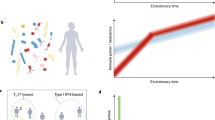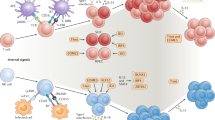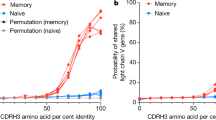Abstract
How do we account for the immune system's ability to produce antibodies in response to new antigens? It has been 50 years since F. Macfarlane Burnet published his answer to this question: the clonal-selection theory of antibody diversity. The idea that specificity for diverse antigens exists before these antigens are encountered was a radical notion at the time, but one that became widely accepted. In this article, Nature Reviews Immunology asks six key scientists for their thoughts and opinions on the clonal-selection theory, from its first proposal to their views of it today.
This is a preview of subscription content, access via your institution
Access options
Subscribe to this journal
Receive 12 print issues and online access
$209.00 per year
only $17.42 per issue
Buy this article
- Purchase on Springer Link
- Instant access to full article PDF
Prices may be subject to local taxes which are calculated during checkout
Similar content being viewed by others
References
Burnet, F. M. A modification of Jerne's theory of antibody production using the concept of clonal selection. Aust. J. Sci. 20, 67–69 (1957).
Burnet, F. M. The mechanism of immunity. Sci. Amer. 204, 158–164 (1961).
Luria S. E. & Delbrück, M. Mutations of bacteria from virus sensitivity to virus resistance. Genetics 28, 491–511 (1943).
Newcombe, H. Origin of bacterial variants. Nature 164, 150–151 (1949).
Lederberg, J. & Lederberg, E. M. Replica plating and indirect selection of bacterial mutants. J. Bacteriol. 63, 399–406 (1952).
Jerne, N. K. The natural selection theory of antibody formation. Proc. Natl Acad. Sci. USA 41, 849–857 (1955).
Burnet, F. M. The Clonal Selection Theory of Acquired Immunity (Cambridge Univ. Press, Cambridge, 1959).
Talmage, D. W. Allergy and immunology. Annu. Rev. Med. 8, 239–256 (1957).
Ehrlich, P. On immunity with special reference to cell life. Proc. R. Soc. 66, 424–428 (1900).
Burnet, F. M. & Fenner, F. The Production of Antibodies 2nd edn (Macmillan and Co., Melbourne, 1949).
Owen, R. D. Immunogenetic consequences of vascular anastomoses between bovine twins. Science 102, 400–401 (1945).
Lederberg, J. Genes and antibodies: do antigens bear instructions for antibody specificity or do they select cell lines that arise by mutation? Science 129, 1649–1653 (1959).
Burnet, F. M. The clonal selection theory of acquired immunity — a Darwinian modification. Aust. J. Sci. 27, 6–7 (1964).
Bretscher, P. A. & Cohn, M. Minimal model for the mechanism of antibody induction and paralysis by antigen. Nature 220, 444–448 (1968).
Bretscher, P. & Cohn, M. A theory of self–nonself discrimination. Science 169, 1042–1049 (1970).
Talmage, D. W. Immunological specificity: unique combinations of selected natural globulins provide an alternative to the classical concept. Science 129, 1643–1648 (1959).
Szilard, L. The molecular basis of antibody formation. Proc. Natl Acad. Sci. USA 46, 293–302 (1960).
Szilard, L. The control of the formation of specific proteins in bacteria and in animal cells. Proc. Natl Acad. Sci. USA 46, 277–292 (1960).
Nossal, G. J. V. & Lederberg, J. Antibody production by single cells. Nature 181, 1419–1420 (1958).
Attardi, G., Cohn, M., Horibata, K. & Lennox, E. S. Antibody formation by rabbit lymph node cells. I. Single cell responses to several antigens. J. Immunol. 92, 335–345 (1964).
Jerne, N. K. & Nordin, A. A. Plaque formation in agar by single antibody-producing cells. Science 140, 405 (1963).
Nossal, G. J. V. & Mäkelä, O. Elaboration of antibodies by single cells. Annu. Rev. Microbiol. 16, 53–74 (1962).
Warner, N. L. Szenberg, A. & Burnet, F. M. The immunological role of different lymphoid organs in the chicken. I. Dissociation of immunological responsiveness. Aust. J. Exp. Biol. Med. Sci. 40, 373–387 (1962).
Trentin, J. & Fahlberg, W. J. in Conceptual Advances in Immunology and Oncology 66–74 (Hoeber-Harper, New York, 1963).
Burnet, F. M. in Conceptual Advances in Immunology and Oncology 72 (Hoeber-Harper, New York, 1963).
Burnet, F. M. in Molecular and Cellular Basis of Antibody Formation 653 (Czech Academy of Sciences, Prague, 1965).
Burnet, F. M. Impact on ideas of immunology. Cold Spring Harbor Symp. Quant. Biol. 32, 1 (1967).
Šterzl, J. & Silverstein, A. M. Developmental aspects of immunity. Adv. Immunol. 6, 337–459 (1966).
Sigal, N. H. & Klinman, N. R. The B-cell clonotype repertoire. Adv. Immunol. 26, 255–337 (1978).
Cohn, M., Monod, J., Pollock. M. R., Spiegelman, S. & Stanier, R. Y. Terminology of enzyme formation. Nature 172, 1096 (1953).
Landsteiner, K. The Specificity of Serological Reactions (Harvard University Press, Cambridge, 1946).
Watson, J. D. & Crick, F. H. Molecular structure of nucleic acids; a structure for deoxyribose nucleic acid. Nature 171, 737–738 (1953).
Billingham, R. E., Brent, L., Medawar, P. B. Actively acquired tolerance of foreign cells. Nature 172, 603–606 (1953).
Dixon, F. J., Talmage, D. W. & Maurer, P. H. Radiosensitive and radioresistant phases in the antibody response. J. Immunol. 68, 693–700 (1952).
Putnam, F. W. & Udin, R. Proteins in multiple myeloma. I. Physicochemical study of serum proteins. J. Biol. Chem. 202, 702–743 (1953).
Taliaferro, W. H. & Taliaferro, L. G. The dynamics of hemolysin formation in intact and splenectomized rabbits. J. Infect. Dis. 87, 37–42 (1950).
Merton, R. K. On The Shoulders Of Giants (University of Chicago Press, Chicago, 1965).
Nossal, G. J. V. One cell, one antibody: prelude and aftermath. Immunol. Rev. 185, 15–23 (2002).
Mäkelä, O. & Karjalainen, K. Inherited immunoglobulin idiotypes of the mouse. Immunol. Rev. 34, 119–138 (1977).
Pauling, L. A theory of the structure and process of formation of antibodies. J. Am. Chem. Soc. 62, 2643–2657 (1940).
Edelman, G. M. Dissociation of γ-globulin. J. Am. Chem. Soc. 81, 3155–3156 (1959).
Hilschmann, N. & Craig, L. C. Amino acid sequence studies with Bence-Jones proteins. Proc. Natl Acad. Sci. USA 53, 1403–1409 (1965).
Edelman, G. Antibody structure and molecular immunology. Ann. NY Acad. Sci. 190, 5–25 (1971).
Porter, R. R. Structural studies of immunoglobulins. Science 180, 713–716 (1973).
Tonegawa, S. Somatic generation of immune diversity. In Vitro Cell. Dev. Biol. 24, 253–265 (1988).
Kim, S., Davis, M., Sinn, E., Patten, P. & Hood, L. Antibody diversity: somatic hypermutation of rearranged VH genes. Cell 27, 573–581 (1981).
Weigert, M. G., Cesari, I. M., Yonkovich, S. J. & Cohn, M. Variability in the λ light chain sequences of mouse antibody. Nature 228, 1045–1047 (1970).
Wu, T. T. & Kabat, E. A. An analysis of the sequences of the variable regions of Bence Jones proteins and myeloma light chains and their implications for antibody complementarity. J. Exp. Med. 132, 211–250 (1970).
Bussard, A. Darwinisme et immunologie. Bull. Soc. Fran. Philosophie 77, 1 (1982) (in French).
Silverstein, A. M. The clonal selection theory: what it really is and why modern challenges are misplaced. Nature Immunol. 3, 793–796 (2002).
Cohen, I. R. The cognitive paradigm and the immunological homunculus. Immunol. Today 13, 490–494 (1992).
Cohen, I. R. Tending Adam's Garden 1–296 (Academic Press, San Diego, 2000).
Matzinger, P. Tolerance, danger, and the extended family. Annu. Rev. Immunol. 12, 991–1045 (1994).
Burnet, F. M. Self and Not-self (Cambridge University Press, Cambridge, 1969).
Silverstein, A. M. & Rose, N. R. On the mystique of the immunological self. Immunol. Rev. 159, 197–206 (1997).
Attardi, G., Cohn, M., Horibata, K. & Lennox, E. S. Antibody formation by rabbit lymph node cells. II. Further observations on the behavior of single antibody-producing cells with respect to their synthetic capacity and morphology. J. Immunol. 92, 346–555 (1964).
Attardi, G., Cohn, M., Horibata, K. & Lennox, E. S. Antibody formation by rabbit lymph node cells. III. The controls for microdrop and micropipet experiments. J. Immunol. 92, 356–371 (1964).
Attardi, G., Cohn, M., Horibata, K. & Lennox, E. S. Antibody formation by rabbit lymph node cells. IV. The detailed methods for measuring antibody synthesis by individual cells, the kinetics of antibody formation by rabbits and the properties of cell suspensions. J. Immunol. 92, 372–390 (1964).
Attardi, G., Cohn, M., Horibata, K. & Lennox, E. S. Antibody formation by rabbit lymph node cells. V. Cellular heterogeneity in the production of antibody to T5. J. Immunol. 93, 94–95 (1964).
Raff, M. C., Feldmann, M. & de Petris, S. Monospecificity of bone marrow-derived lymphocytes. J. Exp. Med. 137, 1024–1030 (1973).
Attardi, G., Cohn, M., Horibata, K. & Lennox, E. S. Symposium on the biology of cells modified by viruses or antigens. II. On the analysis of antibody synthesis at the cellular level. Bact. Rev. 23, 213–223 (1959).
Casellas, R. et al. Contribution of receptor editing to the antibody repertoire. Science 291, 1541–1544 (2001).
Fraenkel, S. et al. Allelic choice governs somatic hypermutation in vivo at the immunoglobulin k-chain locus. Nature Immunol. 8, 715–722 (2007).
Malissen, M. J., et al. Regulation of TCRα and β allelic exclusion during T cell development. Immunol. Today 13, 315–322 (1992).
Cunningham, A. J. in The Generation of Antibody Diversity (ed. Cunningham, A. J.) 69–104 (Academic Press, London, 1976)
McKean, D. K., Staudt, L., Gerhard, W. & Weigert, M. Generation of antibody diversity in the immune response to Influenza. Proc. Natl Acad. Sci. USA 81, 3180–3186 (1984).
Cohn, M., Langman, R. E. & Mata, J. A computerized model for the self-nonself discrimination at the level of the T-helper (Th genesis). I. The origin of “primer” effector T-helpers. Int. Immunol. 14, 1105–1112 (2002).
Langman, R. E., Mata, J. & Cohn, M. A computerized model for the self–nonself discrimination at the level of the T-helper (Th genesis) II. The behavior of the system upon encounter with nonself antigens. Int. Immunol. 15, 593–609 (2003).
Miller, J. Self–Nonself discrimination by T lymphocytes. C. R. Biol. 327, 399–408 (2004).
Janeway, C. The immune system evolved to discriminate infectious nonself from noninfectious self. Immunol. Today 13, 11–16 (1992).
Langman, R. E. & Cohn, M. The E–T (elephant–tadpole) paradox necessitates the concept of a unit of B-cell function: the protection. Mol. Immunol. 24, 675–697 (1987).
Cohn, M. & Langman, R. E. The protecton: the unit of humoral immunity selected by evolution. Immunol. Rev. 115, 11–142 (1990).
Wardemann, H. S. et al. Predominant autoantibody production by early human B cell precursors. Science 301, 1374–1377 (2003).
Witsch, E. J., Cao, H., Fukuyama, H. & Weigert, M. Light chain generates polyreactive antibodies in chronic graft-versus-host reaction. J. Exp. Med. 203, 1761–1772 (2006).
Li, Y., Li, H. & Weigert, M. Autoreactive B cells in the marginal zone that express dual receptors. J. Exp. Med. 195, 181–188 (2002).
Ethics declarations
Competing interests
The authors declare no competing financial interests.
Related links
Glossary
- Instructionist theory
-
The theory that antigen acts as a template to instruct antibody specificity and production, so that antibodies are manufactured in the body de novo in response to a foreign antigen.
- Selectionist theory
-
The theory that the individual has a pre-formed repertoire of antibodies, and that the binding of antigen to antibody triggers the self-replication of the bound antibody (that is, the antigen selects for the antibody).
- Clonal-selection theory
-
(CST). The theory that each B cell has membrane-bound antibody receptors that are specific for one particular antigen, and once an antibody is selected (bound) by an antigen, the cell is stimulated to produce a clone.
Rights and permissions
About this article
Cite this article
Cohn, M., Av Mitchison, N., Paul, W. et al. Reflections on the clonal-selection theory. Nat Rev Immunol 7, 823–830 (2007). https://doi.org/10.1038/nri2177
Issue Date:
DOI: https://doi.org/10.1038/nri2177
This article is cited by
-
Ontologically simple theories do not indicate the true nature of complex biological systems: three test cases
History and Philosophy of the Life Sciences (2020)
-
When humoral became cellular
Nature Immunology (2016)
-
Fashioning the Immunological Self: The Biological Individuality of F. Macfarlane Burnet
Journal of the History of Biology (2014)
-
Dynamics of melanoma tumor therapy with vesicular stomatitis virus: explaining the variability in outcomes using mathematical modeling
Gene Therapy (2012)
-
The autoimmunity of primary biliary cirrhosis and the clonal selection theory
Immunology & Cell Biology (2011)



